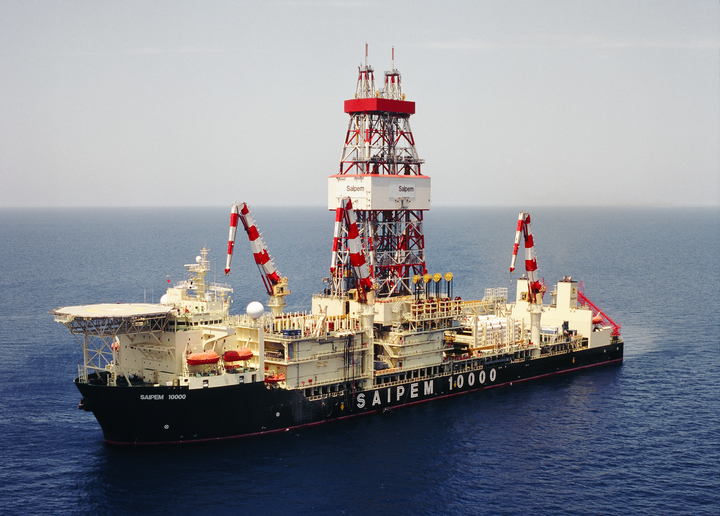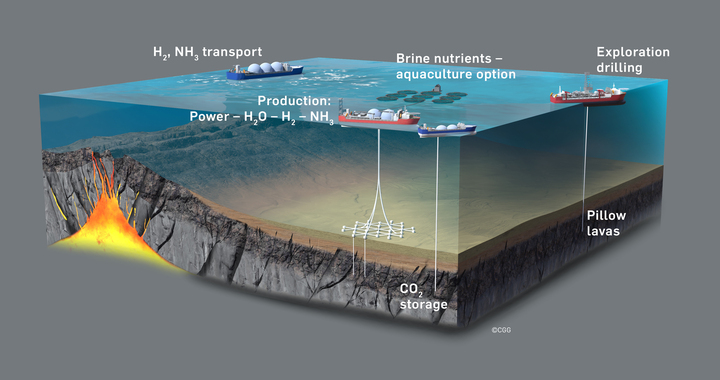Emerging as a promising new chapter in the search for renewable energy sources, offshore geothermal offers firm, baseload energy from beneath the seabed. No commercial offshore plants exist yet, but the combination of supercritical fluids, steep temperature gradients, naturally confined high-pressure systems, and a mature offshore supply chain makes the potential obvious.
It's a global opportunity, stretching across every major ocean
Last year, Viridien (then CGG) released the whitepaper, Offshore Geothermal: A Green Energy Resource of Global Significance. Highlighting the unique proposition of offshore geothermal, Rebecca Bolton, Viridien's geothermal team lead and co-author of the whitepaper said: "Crucially, offshore geothermal can leverage decades of experience in offshore engineering, infrastructure, and project delivery developed by the oil and gas industry, just as offshore wind has done successfully.
"At the same time, it benefits from the global track record of geothermal projects onshore, where the industry has already shown how to harness subsurface heat reliably and responsibly."
That view is echoed by seasoned offshore contractors such as Saipem, a company that brings decades of geothermal and offshore engineering experience.

"Our offshore O&G expertise is highly transferable to offshore geothermal. Many technical challenges, like HPHT drilling, two-phase flow, and subsea infrastructure design, are directly aligned with Saipem's legacy," Davide Manunta, chief technology and innovation officer and director of Sustainable Infrastructures business line, said.
He added: "Geothermal is part of our heritage, from Aquater in the 1970s to today's broader strategy, and we see it as a key piece in decarbonising heat, one of the most difficult areas of the energy transition, while also providing constant and clean electricity."
Global potential
Crucially for its potential, offshore geothermal is a product of geology that repeats itself: spreading centres, back-arc basins and young rifts recur around the planet's oceans, creating a resource that scales globally.
"The biggest surprise for me is just how widespread the potential really is. It isn't confined to one or two isolated regions, it's a global opportunity, stretching across every major ocean," Bolton explained. "And as long as development is guided by strong regulation, with the aim of protecting sensitive ecosystems and ensuring responsible exploration in line with the UN Sustainable Development Goals (SDGs), then this could become the major non-nuclear, ‘always-on' low-carbon energy source for the planet."
From an exploration perspective, young rift systems offer the most promising starting point: mid-ocean spreading centres, back-arc basins, and continental rifts that have been flooded by the sea. They are hot, naturally fractured and, critically, predisposed to fluid flow. The commercial case improves further when these systems are located close to shore or within exclusive economic zones, reducing development risk and simplifying access.
Bolton offered numerous examples of promising locations. "The Gulf of California is a good example, with spreading centres that come right up to the coastline. Another is the Okinawa Trough, where scientists have already recorded venting at over 300C.
"Similar opportunities exist in other regions where rifting and spreading are accessible from land. In Iceland, for instance, the Mid-Atlantic Ridge rises above sea level, and geothermal energy is already a cornerstone of the country's energy system."
For Saipem, a company with Italian origins, the potential of the Mediterranean basin was one of the focus areas of an MoU signed last year to accelerate R&D and feasibility studies for next-generation geothermal. According to the company, the Mediterranean and the Tyrrhenian Sea in particular, combine favourable heat flow, short distances to demand centres and a mature offshore ecosystem.
"Smaller Mediterranean islands face major energy challenges: land scarcity, fossil fuel dependence, and seasonal demand peaks. Offshore geothermal offers firm power without occupying land, making it ideal for these contexts," Manunta said. "Launching pilot projects here aligns with EU policy on clean energy for islands and could quickly demonstrate the technical, economic, and environmental feasibility of marine geothermal, which are all essential aspects."
However, not all of the prizes lie within national jurisdictions. As highlighted in Viridien's white paper, there is enormous potential in international waters, a fact that has both regulatory and technical implications. It is an area the sector flagged early, with proactive engagement of the International Seabed Authority aimed at ensuring clear rules that treat offshore geothermal as a clean energy source and set robust expectations for environmental protection.
Cutting through the uncertainty
The essential subsurface challenge offshore is the same as onshore: find the fractures, faults and pathways that can sustain high-enthalpy fluid flow. What has changed is the sophistication of the toolbox used to see those pathways before the first well is drilled.
"This is where Viridien's core expertise in geoscience and data science really comes into play. Subsurface imaging and machine learning give us a way to cut through the uncertainty and directly image the structures that matter, the fractures, the faults, the pathways where hot fluids can move," Bolton explained. "By layering in data from geology, geophysics, bathymetry, ocean state, and satellite observations, machine learning can let us narrow down huge stretches of oceanic spreading to find the highest-quality prospects."
Notably, the tools are not experimental; they have been successfully applied in many onshore geothermal projects and in early offshore studies, where they have demonstrated their ability to predict reservoir potential before drilling. "That experience gives us confidence that they're ready to inform pre-drill decisions offshore today," Bolton stressed.
Bringing down the levelised cost of energy
"The main barrier to the widespread adoption of offshore geothermal remains economic," Manunta said. The Levelised Cost of Energy for offshore geothermal reflects the complications of a compact bespoke power-conversion system, deepwater operations, and high-temperature drilling.
Drilling in superheated, fractured rock demands materials and tools that retain integrity under extreme thermal and mechanical loads.
Moreover, flow assurance becomes central because high-enthalpy fluids must be transported through cold seawater environments while minimising heat loss, scaling and two-phase instability. The power-conversion systems themselves, whether on floating units or subsea, have to be compact, robust, remotely monitored and designed for low-touch maintenance.
Environmental readiness is equally critical. Protocols for marine monitoring, leak detection and ecosystem protection must be defined and proven.
This means that solutions to enhance the economic viability of offshore geothermal energy are vital. "Economically, offshore geothermal remains costly, but many of the cost drivers mirror onshore geothermal, where Saipem is already active. We expect that applying standardisation, modularisation, and infrastructure reuse, as seen in offshore wind, will help bring LCOE down over time."
The reuse of assets is one lever that can be pulled quickly. Retrofitting decommissioned oil and gas platforms or recompleting depleted wells for geothermal service can reduce both CAPEX and permitting timelines, thereby accelerating deployment.
Equally, conceptual innovation can trim risk and time. A recent patent application by Viridien brings together two elements that, in this combination, are new to the sector. The first is a systematic, multi-criteria method for ranking sites. Rather than relying on intuition or a single dataset, it integrates crustal age, sediment thickness, bathymetry and sea state into a single, repeatable scoring system. The result is faster, more transparent prospect selection. The second is a floating plant concept with a moveable, modular riser system designed for scale. Together, they point to fewer wasted exploration wells and more optionality at development.
The patent also shows how, at the production stage, the constant hydrostatic pressure head provided by the ocean water column can be used to sustain geothermal fluid flow rates.
Adding another layer
Another way to improve the economic proposition is to utilise offshore geothermal energy to anchor multi-service hubs that extract greater value from heat. A concrete example could be Bluenzyme, Saipem's proprietary CO2 capture technology, which can use low-to-medium enthalpy geothermal heat as a process energy source; this concept was recently awarded funding for an onshore project by the European Commission. This integration helps reduce emissions while improving heat recovery efficiency in industrial and energy applications.
This isn't a blue-sky idea, it's already happening
"We are also exploring hybrid offshore platforms that could integrate geothermal with green hydrogen, ammonia, and desalination, enhancing the value proposition," Manunta said.
Because condensate from geothermal plants is essentially distilled water, Bolton also sees freshwater co-production as an obvious way to improve offshore geothermal economics.

"Freshwater remains the most straightforward and immediately valuable co-product. For islands or coastal regions facing chronic water stress, that resource alone could be transformational, directly supporting global goals around water security," she said, adding, "But I'd put hydrogen right alongside it. This isn't a blue-sky idea, it's already happening. In Indonesia, geothermal power and flash condensate are being used today to generate hydrogen, proving the concept at scale. Offshore geothermal could extend that model, pairing 24/7 renewable baseload with ready access to water for electrolysis and creating new opportunities for clean hydrogen or ammonia production close to shipping routes, island economies, and industries like mining, again aligning with wider sustainability objectives."
Those integrations make sense onshore and offshore, but the marine setting adds advantages: minimal land use, fewer conflicts with urban or agricultural zones and very limited visual impact in sensitive coastal areas. Sharing its research openly, Viridien hopes to shorten the time from concept to real projects. "For me, the goal is clear: help offshore geothermal move from being an idea on paper to being a real, deployable part of the clean energy transition," Bolton concluded.



















